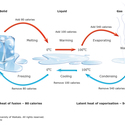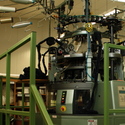The first KiwiNet Research Commercialisation1 Awards (KiwiNet Awards) were held in 2013. The awards celebrate the achievement of individuals, teams and organisations who are involved in commercialising publicly funded research in New Zealand.
In this article, you can read about the winners and finalists in each awards category. Click the video thumbnail to view a short clip and detailed abstract for each winner and finalist.
Commercialisation Collaboration Award
According to the kiwinet.org.nz website, the Commercialisation Collaboration2 Award “recognises the outstanding new collaborations formed between multiple research organisations working together to build national scale around a technology platform or address a business need”.
Callaghan Innovation3 was the winner in this award category for its part in Ovine Automation Ltd, a research-industry collaboration that is developing new robotics approaches to meat processing. The other finalists were Aldera Health, for developing an animal and plant research ‘corridor’ in New Zealand, and Plant & Food Research, who worked with AgResearch to establish Land Use Change and Intensification (a collaborative programme to help farmers optimise4 their land use).
Researcher Entrepreneur Award
This award celebrates individual researchers who have either created innovative businesses or contributed strongly to business innovation.
The winners of the Researcher Entrepreneur Award were Professors Grant Covic and John Boyes (University of Auckland). Grant and John are pioneers in wireless power5 transfer – an innovative technology that has received considerable interest from car manufacturers and others worldwide.
The other finalists in this category were Dr John Abrahamson (ArcActive), for improving the stop/start profile of existing lead acid6 batteries, and Professors Bill Wilson and Bill Denny (Auckland Cancer7 Society Research Centre), for the Centre’s strong record in developing anticancer compounds to clinical trial8 stage.
Research and Business Partnership Award
With this award, KiwiNet recognises that a strong working relationship between business and a research organisation can be of significant commercial value to New Zealand.
The winners of the Research and Business Partnership Award were Callaghan Innovation, for their productive partnership with Electronic Navigation Ltd. The partnership has led to the development of the Wide Angle Sonar9 Seafloor Profiler (WASSP), an advanced sonar technology that is exported to over 30 countries worldwide.
The other finalists in this category were Auckland University of Technology (AUT), for their work with the Cloudy Bay Group to grow New Zealand’s surf clam industry, and Lincoln University, for its role in the New Zealand Seed10 Industry Alliance.
Commercial Deal Award
The Commercial Deal Award recognises excellence in research commercialisation.
The winner of the Commercial Deal Award was Otago Innovation, for its work to bring the National Poison11 Centre’s TOXINZ database to a broad international market. The other finalists in this category were Grasslanz Technology, for their innovative pasture technologies, and Aduro Biopolymers, for their commercialisation of a novel12 bioplastic13 derived from bloodmeal.
People’s Choice Supreme Award
Last but not least! The People’s Choice Supreme Award recognises overall excellence in research commercialisation. It was voted on by KiwiNet Awards attendees.
The winner of the People’s Choice Supreme Award was AUT, for its work with the Cloudy Bay Group to grow New Zealand’s (currently small) surf clam industry. AUT was a finalist in the Research and Business Partnership Award for the same work (see above). The team at AUT, led by Associate Professor Lindsey White, have established a particularly strong collaboration with the Cloudy Bay Group that is providing answers to key questions about New Zealand’s harvestable surf clam population14.
Activity idea
This unit plan describes how students can design a disposable product as a sustainable15 alternative to an existing product using potato starch16. This encourages students to develop their design and innovation skills in the context of increasing plastics use. They will also gain understanding of the challenges of developing sustainable alternatives.
The KiwiNet Awards celebrate successful innovation in New Zealand. To explore the concept of innovation further in a New Zealand context, students could use this activity on unpacking innovation.
Related content
Take a look at some of the other winners of the Kiwinet Awards in 2014, 2015, 2016, 2017 and 2018.
Useful link
The KiwiNet Research Commercialisation Awards celebrate the achievements of individuals, teams and organisations turning research excellence into economic or social gain.
Check out the KiwiNet website and their YouTube channel to view videos of the winners and finalists, information about the award categories, biographies of the judges and more.
- commercialisation: To take an idea and turn it into a business in order to make money from it.
- collaboration: Working together with a common purpose.
- Innovation: The development of a new process or product that is then used by others.
- optimise: Modify to achieve maximum efficiency.
- power: 1. The rate at which work is done (defined as work divided by time taken). 2. Mechanical or physical energy, force or momentum.
- acid: A hydrogen-containing substance that is capable of donating a hydrogen ion to another substance.
- cancer: The term for a group of more than 100 diseases in which abnormal cells divide and multiply uncontrollably.
- clinical trial: A carefully planned study that evaluates the benefits and risks of treatments and screening tests on humans. Also called research studies or medical research, clinical trials help establish the safety and effectiveness of new drugs or treatments.
- sonar: A method of detecting, locating, and determining the speed of objects through the use of reflected sound waves. A sound signal is produced, and the time it takes for the signal to reach an object and for its echo to return is used to calculate the object's distance.
- seed: 1. Part of the sexual reproduction of angiosperms (flowering plants) and gymnosperms (cone plants). Contains an embryo and its food store, which creates a new plant when conditions are right. 2. Offspring or progeny.
- poison: A substance that, through its chemical action, usually kills, injures or impairs an organism.
- novel: New or unusual in an interesting way.
- bioplastic: A plastic material that is either biodegradable or derived from renewable resources or both.
- population: In biology, a population is a group of organisms of a species that live in the same place at a same time and that can interbreed.
- sustainable: A way of using natural products so they are available for future generations.
- starch: A complex carbohydrate found chiefly in seeds, fruits, tubers, roots and stem pith of plants. Commonly found in foods, such as potatoes, wheat, rice and corn.




